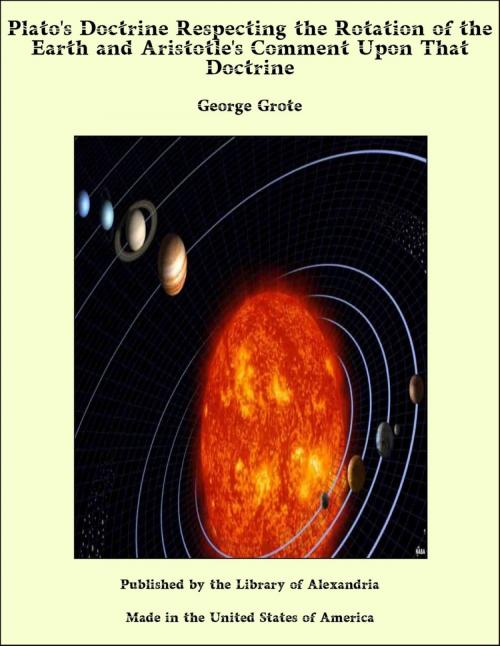Plato's Doctrine Respecting the Rotation of the Earth and Aristotle's Comment Upon That Doctrine
Nonfiction, Religion & Spirituality, New Age, History, Fiction & Literature| Author: | George Grote | ISBN: | 9781465613349 |
| Publisher: | Library of Alexandria | Publication: | March 8, 2015 |
| Imprint: | Language: | English |
| Author: | George Grote |
| ISBN: | 9781465613349 |
| Publisher: | Library of Alexandria |
| Publication: | March 8, 2015 |
| Imprint: | |
| Language: | English |
The obscurity of this passage is amply attested by the numerous differences of opinion to which it has given rise, both in ancient and in modern times. Various contemporaries of Plato (νιοι — Aristot. De Coelo, II. 13, p. 293 b. 30) understood it as asserting or implying the rotatory movement of the earth in the centre of the Kosmos, and adhered to this doctrine as their own. Aristotle himself alludes to these contemporaries without naming them, and adopts their interpretation of the passage; but dissents from the doctrine, and proceeds to impugn it by arguments. Cicero mentions (Academic II. 39) that there were persons who believed Plato to have indicated the same doctrine obscurely, in his Timaeus: this passage must undoubtedly be meant. Plutarch devotes a critical chapter to the enquiry, what was Plato’s real doctrine as to the cosmical function of the earth — its movement or rest (Quaestion. Platonic. VII. 3, p. 1006.) There exists a treatise, in Doric dialect, entitled Τίμαίω τ Λόκρω Περ Ψυχς Κόσμω κα Φύσιος, which is usually published along with the works of Plato. This treatise was supposed in ancient times to be a genuine production of the Lokrian Timaeus, whom Plato introduces as his spokesman in the dialogue so called. As such, it was considered to be of much authority in settling questions of interpretation as to the Platonic Timaeus. But modern critics hold, I believe unanimously, that it is the work of some later Pythagorean or Platonist, excerpted or copied from the Platonic Timaeus. This treatise represents the earth as being in the centre and at rest. But its language, besides being dark and metaphorical, departs widely from the phraseology of the Platonic Timaeus: especially in this — that it makes no mention of the cosmical axis, nor of the word λλομένην or ελουμένην. Alexander of Aphrodisias (as we learn from Simplikius ad Aristot. De Coelo, fol. 126) followed the construction of Plato given by Aristotle. “It was improbable (he said) that Aristotle could be ignorant either what the word signified, or what was Plato’s purpose” (λλ τ ριστοτέλει, φησν, οτω λέγοντιλλεσθαι, οκ ελογον ντιλέγειν· ς ληθς γρ οτε τς λέξεως τ σημαινόμενον εκς ν γνοεν ατν, οτε τν Πλάτωνος σκοπόν. This passage is not given in the Scholia of Brandis). Alexander therefore construed λλομένην as meaning or implying rotatory movement, though in so doing he perverted (so Simplikius says) the true meaning to make it consonant with his own suppositions.
The obscurity of this passage is amply attested by the numerous differences of opinion to which it has given rise, both in ancient and in modern times. Various contemporaries of Plato (νιοι — Aristot. De Coelo, II. 13, p. 293 b. 30) understood it as asserting or implying the rotatory movement of the earth in the centre of the Kosmos, and adhered to this doctrine as their own. Aristotle himself alludes to these contemporaries without naming them, and adopts their interpretation of the passage; but dissents from the doctrine, and proceeds to impugn it by arguments. Cicero mentions (Academic II. 39) that there were persons who believed Plato to have indicated the same doctrine obscurely, in his Timaeus: this passage must undoubtedly be meant. Plutarch devotes a critical chapter to the enquiry, what was Plato’s real doctrine as to the cosmical function of the earth — its movement or rest (Quaestion. Platonic. VII. 3, p. 1006.) There exists a treatise, in Doric dialect, entitled Τίμαίω τ Λόκρω Περ Ψυχς Κόσμω κα Φύσιος, which is usually published along with the works of Plato. This treatise was supposed in ancient times to be a genuine production of the Lokrian Timaeus, whom Plato introduces as his spokesman in the dialogue so called. As such, it was considered to be of much authority in settling questions of interpretation as to the Platonic Timaeus. But modern critics hold, I believe unanimously, that it is the work of some later Pythagorean or Platonist, excerpted or copied from the Platonic Timaeus. This treatise represents the earth as being in the centre and at rest. But its language, besides being dark and metaphorical, departs widely from the phraseology of the Platonic Timaeus: especially in this — that it makes no mention of the cosmical axis, nor of the word λλομένην or ελουμένην. Alexander of Aphrodisias (as we learn from Simplikius ad Aristot. De Coelo, fol. 126) followed the construction of Plato given by Aristotle. “It was improbable (he said) that Aristotle could be ignorant either what the word signified, or what was Plato’s purpose” (λλ τ ριστοτέλει, φησν, οτω λέγοντιλλεσθαι, οκ ελογον ντιλέγειν· ς ληθς γρ οτε τς λέξεως τ σημαινόμενον εκς ν γνοεν ατν, οτε τν Πλάτωνος σκοπόν. This passage is not given in the Scholia of Brandis). Alexander therefore construed λλομένην as meaning or implying rotatory movement, though in so doing he perverted (so Simplikius says) the true meaning to make it consonant with his own suppositions.















